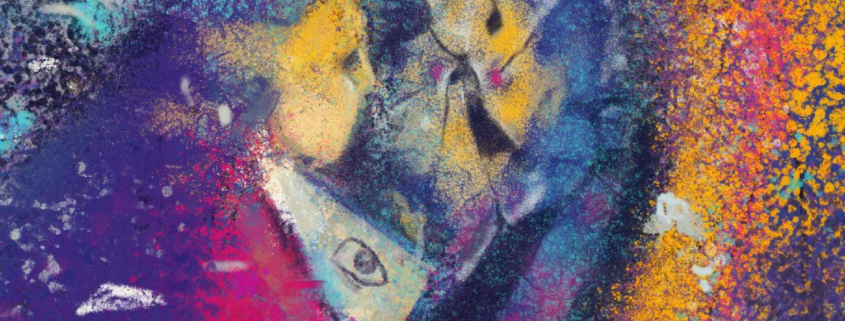Your College Unnie: Two faces at once

Mirror, mirror, on the wall, who’s the fairest of them all?
A young woman studies her reflection in the glass. Ebony-haired with dark almond eyes, her lips are full, cheekbones subtly peachy. Her eyebrows are straight, skin clear and pale, nose gently sloped. She gives a shy, tight-lipped smile. Swishing wispy layers out of her eyes, the woman studies herself for a moment before flipping the mirror in her hand.
Suddenly, the young lady we became acquainted with is gone. In the glass is another, with sunkissed skin, arched brows and heavier makeup. Strands of blond streak her hair. She flashes a bright smile, crinkling her eyes while revealing rows of pearly whites. Her face looks stronger, more angular … perhaps even more muscular?
“Mirror, mirror …”
Twice the culture, twice the food, twice the number of holidays! But, as a “______ American,” — Korean American, in my case — this also means twice the beauty standards. Each culture has different values and interpretations of “beauty.” Separately, this isn’t really an issue, but it’s not often that I find myself able to float seamlessly between the two standards. Much more commonly, it feels like they’re at war with each other.
My Korean side champions pale “glass” skin, a dainty nose and wide eyes with double lids and aegyo sal. Everything should be dainty, light and feminine but natural at the same time. Makeup should be minimal, but also represent a shy, well-mannered and polite personality. Cheeks should have enough fat to be cute, but not too much, of course.
My American side insists that everything should be viewed through gold-tinted lenses that are too tiny to be practical. Don’t ask why. I’ve been asking for ages, and I still don’t know. Something about Sunkist and Jennifer Coolidge …? Everything here is stronger. The makeup. The features. The personality. The approach. It’s bolder. More colorful. Assertive.
Let’s put it this way: If my Korean side is Athena, my American side is Minerva.
My Korean side is soft-spoken but still strong.
My Americ— “WAR WAR WAR WAR WAR WAR WAR WAR WA—”
<CRASH!>
<SLAM!>
Sorry. As you can see, things are pretty chaotic around here.
Akin to the stylists that give Mulan a makeover, each side pulls my face in different directions to fit its standards.
“Let’s go in the sun, we need to tan!”
“Here, take this umbrella and sunscreen. Stay in the shade.”
In Korea, light skin is associated with being young, innocent and beautiful. A history of deep-rooted, classist culture favors pale skin — it’s seen as a sign of high socioeconomic status. Traditionally, those in society who had lower levels of income typically undertook high labor, outdoor work, which tanned their skin. Even today, beauty products are catered toward lighter skin tones; it’s rare to find Korean cosmetics designed for darker complexions. Skin whiteners are easily found on the market.
American beauty trends typically favor looking older and more mature. A cosmetic surgery, called “buccal fat removal,” has recently been circulating on social media platforms and among American celebrities. Buccal fat pads are pockets of fat in the corners where your cheeks meet your mouth. This surgery removes pads to thin and hollow out the cheeks, creating a more pronounced, striking and gaunt impression.
American beauty standards align strongly with sensuality and individuality. To be distinguishable as an individual is to be iconic. However, in Korea, trends serve a different purpose: to be followed, not led.
Perhaps it’s in culture that we can find context for these warring expectations.
America is a melting pot of diversity, cultures, ideas and individuals. It’s not an ethno-state, nor could it be due to its expanse. In America, freedom, liberty and individualism are celebrated — to the point that it’s entwined in core legal documents, like the Constitution and Declaration of Independence.
South Korea is a homogenous society. Ethnic Koreans hold an absolute majority. Korean culture is traditionally conservative, and while there has been some change and activism with modern times, it still holds many of its traditional values today.
Growing up with both standards was challenging. Even today, I’m not exactly sure where I fit in with all of this. Do I style my closet with Korean fashion or American trends? Arched or straight brows? Should I be the suntanned Korean or the sun-deprived American?
Yet, amid this confusion, I’ve incorporated the beauty of both cultures into my life. Korea’s graceful nature, subtlety and calm-kindness are all traits I admire. Likewise, I respect the assertiveness, confidence and vibrancy present in American culture.
Like strands of hair in a braid, I am weaving my experiences, background and culture together to form my identity. This is all that I have. Regardless of whether my experiences as a Korean American are positive or negative, they are incorporated nevertheless. I learn from both.
Unless I have no hair and I’m Professor Quirrell with Voldemort. Can you imagine that?
Victoria Lee is a freshman writing about the AAPI experience in America. She is also the Wellness and Community Outreach Director for the Daily Trojan. Her column, “Your College Unnie,” usually runs every other Wednesday.

